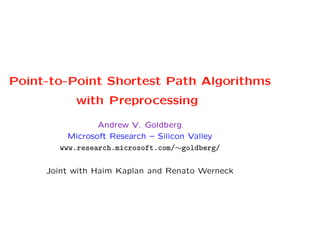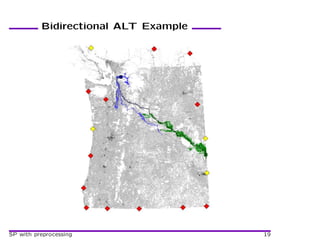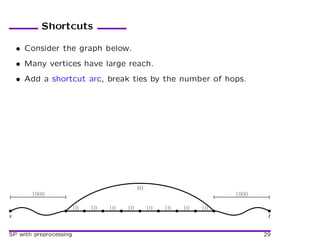The document discusses algorithms for finding shortest paths in graphs, with a focus on point-to-point shortest path problems with preprocessing. It introduces Dijkstra's algorithm, bidirectional Dijkstra, and A* search. It describes how these algorithms work and their tradeoffs. The document also discusses computing lower bounds on distances using techniques like the triangle inequality to guide search.



![Shortest Path Problem
Input: Directed graph G = (V, A), nonnegative length function
: A → R+ , origin s ∈ V , destination t ∈ V .
Preprocessing: Limited space to store results.
Query: Find a shortest path from s to t.
Interested in exact algorithms that search a (small) subgraph.
Related work: reach-based routing [Gutman 04], hierarchi-
cal decomposition [Schultz, Wagner & Weihe 02], [Sanders &
Schultes 05, 06], geometric pruning [Wagner & Willhalm 03], arc
flags [Lauther 04], [K¨hler, M¨hring & Schilling 05], [M¨hring
o o o
et al. 06].
SP with preprocessing 3](https://image.slidesharecdn.com/20080601ppspgoldberg-100622234412-phpapp01/85/Andrew-Goldberg-An-Efficient-Point-to-Point-Shortest-Path-Algorithm-4-320.jpg)



![Dijkstra’s Algorithm
[Dijkstra 1959], [Dantzig 1963].
• At each step scan a labeled vertex with the minimum label.
• Stop when t is selected for scanning.
Work almost linear in the visited subgraph size.
Reverse Algorithm: Run algorithm from t in the graph with all
arcs reversed, stop when t is selected for scanning.
Bidirectional Algorithm
• Run forward Dijkstra from s and backward from t.
• Maintain µ, the length of the shortest path seen: when scan-
ning an arc (v, w) such that w has been scanned in the other
direction, check if the corresponding s-t path improves µ.
• Stop when about to scan a vertex x scanned in the other
direction.
• Output µ and the corresponding path.
SP with preprocessing 7](https://image.slidesharecdn.com/20080601ppspgoldberg-100622234412-phpapp01/85/Andrew-Goldberg-An-Efficient-Point-to-Point-Shortest-Path-Algorithm-8-320.jpg)




![A∗ Search
[Doran 67], [Hart, Nilsson & Raphael 68]
Motivated by large search spaces (e.g., game graphs).
Similar to Dijkstra’s algorithm but:
• Domain-specific estimates πt(v) on dist(v, t) (potentials).
• At each step pick a labeled vertex with the minimum k(v) =
ds(v) + πt(v).
Best estimate of path length.
• In general, optimality is not guaranteed.
1
11
00
111111
000000
2
1
0
1111111
3
11
00
111111
0
4
1
0
00000000000000000
111111
0 1111111
0000000
11
00
111111
000000 1
0 11
00 1
0
1111111
0000000
11
00
111111
000000 1
0 11
00 1
0
1111111
0000000
111111
000000
0 4
111111
000000 3 2 1111111
0000000
1 5
1111111
0000000
11111111111
00000000000
111111
000000
1
0
11111111111
00000000000 1111111
0000000
1
0
1111111
0000000
1
0
11111111111
00000000000 1
0
1111111
0000000
11111111111
00000000000 1111111
0000000
0
11111111111
00000000000
11111111111
00000000000 1111111
0000000
1111111
0000000
1
0
1
0 11
00
111111 1
0
00000000000
111111
0
11
00 1
0
6 2 1
SP with preprocessing 12](https://image.slidesharecdn.com/20080601ppspgoldberg-100622234412-phpapp01/85/Andrew-Goldberg-An-Efficient-Point-to-Point-Shortest-Path-Algorithm-13-320.jpg)

![Computing Lower Bounds
Euclidean bounds:
[folklore], [Pohl 71], [Sedgewick & Vitter 86].
For graph embedded in a metric space, use Euclidean distance.
Limited applicability, not very good for driving directions.
We use triangle inequality
a000
1111111111111
0000000000000
111
b
11111111111111
00000000000000
111
000
11 11111111111111
00 00000000000000
1111111111111
0000000000000
111
000 1
0
111
000
11 11111111111111
00 00000000000000
1111111111111
0000000000000
111
000 1
0
111
000
1111111111111
0000000000000
111
000
11111111111111
00000000000000
1111111111111
0000000000000
111
000 111
000
11111111111111
00000000000000
111
000
1
0 11
00
1111111111111
0000000000000
111
000
11111111111111
00000000000000
11111111111111
00000000000000
1
0
1
0
11
00
11
00
v w
dist(v, w) ≥ dist(v, b)−dist(w, b); dist(v, w) ≥ dist(a, w)−dist(a, v).
SP with preprocessing 14](https://image.slidesharecdn.com/20080601ppspgoldberg-100622234412-phpapp01/85/Andrew-Goldberg-An-Efficient-Point-to-Point-Shortest-Path-Algorithm-15-320.jpg)


![Bidirectional Lowerbounding
Forward reduced costs: πt (v, w) = (v, w) − πt(v) + πt(w).
Reverse reduced costs: πs (v, w) = (v, w) + πs(v) − πs(w).
Fact: πt and πs give the same reduced costs iff πs + πt = const.
[Ikeda et at. 94]: use ps(v) = πs(v)−πt(v) and pt (v) = −ps(v).
2
Other solutions possible. Easy to loose correctness.
ALT algorithms use A∗ search and landmark-based lower bounds.
SP with preprocessing 17](https://image.slidesharecdn.com/20080601ppspgoldberg-100622234412-phpapp01/85/Andrew-Goldberg-An-Efficient-Point-to-Point-Shortest-Path-Algorithm-18-320.jpg)



![Related Systems Work
Network delay estimation:
Use delays to beacons to estimate arbitrary node delays.
E.g., IDMaps [Francis et al. 01].
Theoretical analysis [Kleinberg, Slivkins & Wexler 04]: for ran-
dom beacons and bounded doubling dimension graphs, get good
bounds for most node pairs.
Good bounds are not enough to prove bounds on ALT.
SP with preprocessing 21](https://image.slidesharecdn.com/20080601ppspgoldberg-100622234412-phpapp01/85/Andrew-Goldberg-An-Efficient-Point-to-Point-Shortest-Path-Algorithm-22-320.jpg)

![Reaches
[Gutman 04]
• Consider a vertex v that splits a path P into P1 and P2.
rP (v) = min( (P1), (P2)).
• r(v) = maxP (rP (v)) over all shortest paths P through v.
Using reaches to prune Dijkstra:
LB(w,t)
d(s,v) v w
s t
If r(w) < min(d(v) + (v, w), LB(w, t)) then prune w.
SP with preprocessing 23](https://image.slidesharecdn.com/20080601ppspgoldberg-100622234412-phpapp01/85/Andrew-Goldberg-An-Efficient-Point-to-Point-Shortest-Path-Algorithm-24-320.jpg)

![Computing Reaches
• A natural exact computation uses all-pairs shortest paths.
• Overnight for 0.3M vertex graph, years for 30M vertex graph.
• Have a heuristic improvement, but it is not fast enough.
• Can use reach upper bounds for query search pruning.
Iterative approximation algorithm: [Gutman 04]
• Use partial shortest path trees of depth O( ) to bound reaches
of vertices v with r(v) < .
• Delete vertices with bounded reaches, add penalties.
• Increase and repeat.
Query time does not increase much; preprocessing faster but still
not fast enough.
SP with preprocessing 25](https://image.slidesharecdn.com/20080601ppspgoldberg-100622234412-phpapp01/85/Andrew-Goldberg-An-Efficient-Point-to-Point-Shortest-Path-Algorithm-26-320.jpg)







![Shortcuts
[Sanders & Schultes 05, 06]: similar idea in hierarchy-based al-
gorithm; similar performance.
• During preprocessing we shortcut small-degree vertices every
time is updated.
• Shortcut replaces a vertex by a clique on its neighbors.
• A constant number of arcs is added for each deleted vertex.
• Shortcuts greatly speed up preprocessing.
• Shortcuts speed up queries.
SP with preprocessing 33](https://image.slidesharecdn.com/20080601ppspgoldberg-100622234412-phpapp01/85/Andrew-Goldberg-An-Efficient-Point-to-Point-Shortest-Path-Algorithm-34-320.jpg)











![Concluding Remarks
• Our heuristics work well on road networks.
• Recent improvements: [Bast et al. 07, Geisberger et al. 08].
• How to select good shortcuts? (Road networks/grids.)
• For which classes of graphs do these techniques work?
• Need theoretical analysis for interesting graph classes.
• Interesting problems related to reach, e.g.
◦ Is exact reach as hard as all-pairs shortest paths?
˜
◦ Constant-ratio upper bounds on reaches in O(m) time.
• Dynamic graphs (real-time traffic).
SP with preprocessing 45](https://image.slidesharecdn.com/20080601ppspgoldberg-100622234412-phpapp01/85/Andrew-Goldberg-An-Efficient-Point-to-Point-Shortest-Path-Algorithm-46-320.jpg)